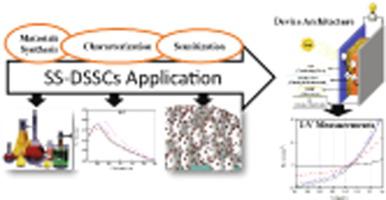Spectrochimica Acta Part A: Molecular and Biomolecular Spectroscopy ( IF 4.3 ) Pub Date : 2022-05-14 , DOI: 10.1016/j.saa.2022.121387 Naimat Ullah 1 , Şule Erten-Ela 2 , Syed Mujtaba Shah 3 , Hazrat Hussain 3 , Rotaba Ansir 3 , Samina Qamar 1

|
A photoactive nanohybrid material consisting of pyrocatechol violet, carminic acid and dithizone dyes functionalized silver and neodymium-doped TiO2/ZnO nanostructured materials is reported here, as photoactive blend, for solid-state dye sensitized solar cell. First of all we synthesized metals (silver, neodymium) doped (TiO2) Titanium oxide nanoparticles and their nanocomposites (TiO2/ZnO, M−TiO2/ZnO) using the sol–gel and reflux technique, respectively. The synthesized samples were then characterized by UV–Visible spectroscopy, X-Ray diffraction Analysis (XRD), Scanning electron microscopy (SEM), Energy dispersive X-Ray Analysis (EDX), and Fourier Transform infrared spectroscopy (FTIR). Optical studies were done through UV–Visible spectroscopy and the absorption spectra were used to calculate band gaps. The value of the energy gap for TiO2 nanoparticles is 3.10 eV which was gradually tuned to 2.47 eV after incorporating metals (Ag and Nd) and forming respective nanocomposites. X-Ray diffraction Analysis (XRD) patterns revealed the purity and crystallinity in samples. Scanning electron microscopy (SEM) confirmed the irregular morphology (nanorods and spherical shaped) of ZnO and TiO2 nanostructures respectively. The elemental composition of nanomaterials was successfully investigated using energy dispersive X-ray analysis (EDX). In the absence of any impurities, Fourier Transform infrared spectroscopy (FTIR) was used to identify the functional groups in synthesized material. For device fabrication, a solid-state electrolyte, P3HT, a hole conducting polymer was used. Characterization of fabricated solar cells was done using I-V measurements. Under simulated solar irradiation, the DSSC based on pyrocatechol violet sensitized neodymium doped TiO2/ZnO nanohybrid materials exhibited the best PCE (power conversion efficiency) of 2.38 % and significantly improved Jsc (short circuit current density) of 15.68 mA/cm2 as compared to carminic acid and dithizone in photovoltaic measurements. The improved power conversion efficiency of this device is ascribed to the particle size, increased dye adsorption, increased surface area and thus improved short circuit current density (Jsc).
中文翻译:

选择的有机染料(胭脂红酸、邻苯二酚紫和双硫腙)敏化金属(银、钕)掺杂的 TiO2/ZnO 纳米结构材料:用于混合体异质结太阳能电池的光阳极
本文报道了一种由邻苯二酚紫、胭脂红酸和双硫腙染料功能化的银和掺钕的 TiO 2 /ZnO 纳米结构材料组成的光活性纳米杂化材料,作为光活性混合物,用于固态染料敏化太阳能电池。首先,我们合成了金属(银、钕)掺杂的(TiO 2)二氧化钛纳米颗粒及其纳米复合材料(TiO 2 /ZnO,M-TiO 2/ZnO)分别使用溶胶-凝胶和回流技术。然后通过紫外-可见光谱、X 射线衍射分析 (XRD)、扫描电子显微镜 (SEM)、能量色散 X 射线分析 (EDX) 和傅里叶变换红外光谱 (FTIR) 对合成的样品进行表征。通过紫外-可见光谱进行光学研究,并使用吸收光谱来计算带隙。TiO 2纳米粒子的能隙值为3.10 eV,在掺入金属(Ag和Nd)并形成各自的纳米复合材料后逐渐调整为2.47 eV。X 射线衍射分析 (XRD) 图案揭示了样品的纯度和结晶度。扫描电子显微镜 (SEM) 证实了 ZnO 和 TiO 2的不规则形态(纳米棒和球形)分别为纳米结构。使用能量色散 X 射线分析 (EDX) 成功地研究了纳米材料的元素组成。在不存在任何杂质的情况下,使用傅里叶变换红外光谱 (FTIR) 来识别合成材料中的官能团。对于器件制造,使用了一种固态电解质 P3HT,它是一种空穴导电聚合物。使用 IV 测量对制造的太阳能电池进行表征。在模拟太阳照射下,基于邻苯二酚紫敏化钕掺杂TiO 2 /ZnO纳米杂化材料的DSSC表现出最佳的2.38%的PCE(功率转换效率)和显着提高的15.68 mA/cm 2的Jsc(短路电流密度)与光伏测量中的胭脂红酸和双硫腙相比。该器件提高的功率转换效率归因于颗粒尺寸、染料吸附增加、表面积增加,从而提高了短路电流密度 (Jsc)。











































 京公网安备 11010802027423号
京公网安备 11010802027423号